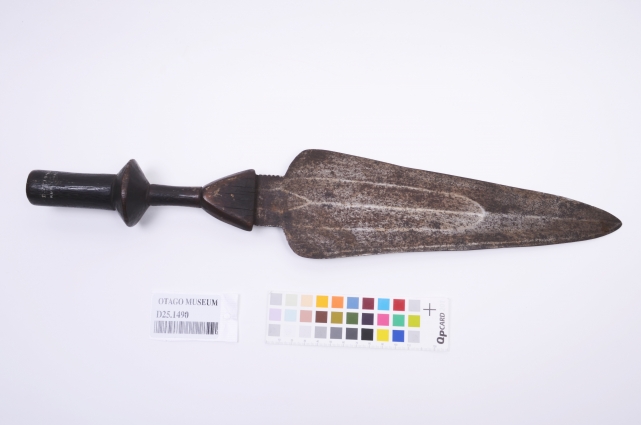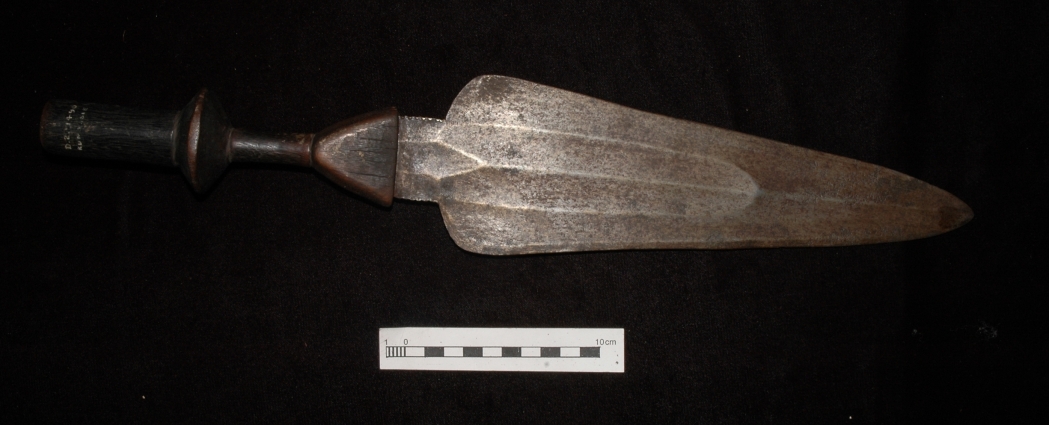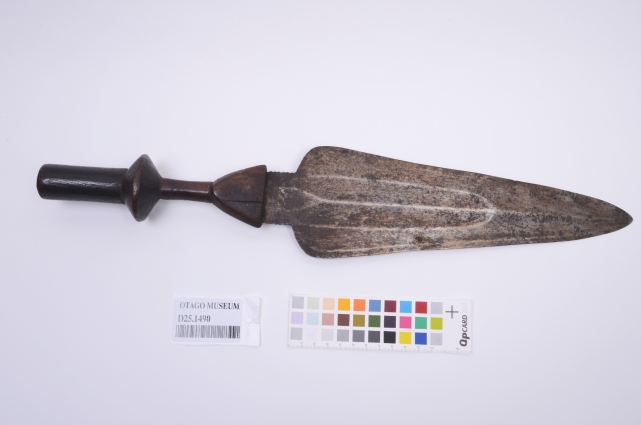Dagger, D25.1490
Physical Description
Broad knife blade with carved wooden handle. Wooden handle is of dark wood. At top end it is a cylinder -which serves as main handle portion - which progresses to become a disc, narrows to a more narrow and somewhat shorter cylinder which widens as the apex end of a flat triangle. The flat iron shaft of the flat symmetrical blade exists from the handle at the base end of the handles triangle. This shaft with parallel and somewhat jagged sides shortly widens to form the shoulders of the main body of the blade - and the widest part of the blade - which then round and begin to taper the full length of the blade terminating in a somewhat rounded point. A raised rib runs the length of the blade from the point terminating in a narrow bifurcation before it enters the base of the handle. Likewise a 'rib' runs the full length of the right edge (as seen when held by the handle in an upright position in front of you) of the bridge. i.e. only one edge of each side of the blade has the rib or ridge. Approximately 1/3 of the way up from the point of the blade the base of a 'U' shaped bridge equally straddles the centre rib with either side of the 'U' running up to the shoulders of the blade. The mid-rib, bifurcation portion, and 'U' rib appear on both sides/surfaces of the blade.
Research Notes
?Possibly more in area of central Africa, e.g. Congo/Zaire. Some semblance to the ceremonial knives of the Kuba people.
Likely for ceremonial purposes and/or as symbol of authority.
Broad knife blade with carved wooden handle. Wooden handle is of dark wood. At top end it is a cylinder -which serves as main handle portion - which progresses to become a disc, narrows to a more narrow and somewhat shorter cylinder which widens as the apex end of a flat triangle. The flat iron shaft of the flat symmetrical blade exists from the handle at the base end of the handles triangle. This shaft with parallel and somewhat jagged sides shortly widens to form the shoulders of the main body of the blade - and the widest part of the blade - which then round and begin to taper the full length of the blade terminating in a somewhat rounded point. A raised rib runs the length of the blade from the point terminating in a narrow bifurcation before it enters the base of the handle. Likewise a 'rib' runs the full length of the right edge (as seen when held by the handle in an upright position in front of you) of the bridge. i.e. only one edge of each side of the blade has the rib or ridge. Approximately 1/3 of the way up from the point of the blade the base of a 'U' shaped bridge equally straddles the centre rib with either side of the 'U' running up to the shoulders of the blade. The mid-rib, bifurcation portion, and 'U' rib appear on both sides/surfaces of the blade. The blade is somewhat pitted with corrosion. The triangular portion of the handle has what appears to be either stress and/or drying fractures on it. Wear patina on the initial/top part of the handle suggests it has been handled/used. General appearance is of a well made object in good condition.
Full length of knife (with handle) = approx. 474mm. Length of handle only = approx. 172mm. Width of blade at shoulders (widest) = approx. 89.9mm. Thickness of blade at thickest = approx. 4.6mm. —Joel A Vanderburg
Likely for ceremonial purposes and/or as symbol of authority.
Broad knife blade with carved wooden handle. Wooden handle is of dark wood. At top end it is a cylinder -which serves as main handle portion - which progresses to become a disc, narrows to a more narrow and somewhat shorter cylinder which widens as the apex end of a flat triangle. The flat iron shaft of the flat symmetrical blade exists from the handle at the base end of the handles triangle. This shaft with parallel and somewhat jagged sides shortly widens to form the shoulders of the main body of the blade - and the widest part of the blade - which then round and begin to taper the full length of the blade terminating in a somewhat rounded point. A raised rib runs the length of the blade from the point terminating in a narrow bifurcation before it enters the base of the handle. Likewise a 'rib' runs the full length of the right edge (as seen when held by the handle in an upright position in front of you) of the bridge. i.e. only one edge of each side of the blade has the rib or ridge. Approximately 1/3 of the way up from the point of the blade the base of a 'U' shaped bridge equally straddles the centre rib with either side of the 'U' running up to the shoulders of the blade. The mid-rib, bifurcation portion, and 'U' rib appear on both sides/surfaces of the blade. The blade is somewhat pitted with corrosion. The triangular portion of the handle has what appears to be either stress and/or drying fractures on it. Wear patina on the initial/top part of the handle suggests it has been handled/used. General appearance is of a well made object in good condition.
Full length of knife (with handle) = approx. 474mm. Length of handle only = approx. 172mm. Width of blade at shoulders (widest) = approx. 89.9mm. Thickness of blade at thickest = approx. 4.6mm. —Joel A Vanderburg
Provenance
Locality:
Kumasi
Measurements
Maximum dimensions (H x W x D): 480 x 90 x 60mmAll Rights Reserved








